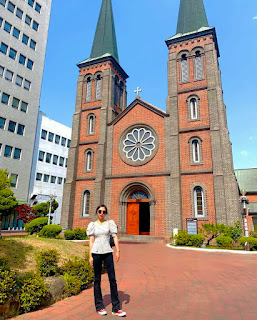- Get link
- X
- Other Apps
Featured Post
- Get link
- X
- Other Apps
#Daegu #Visitdaegu #Delightdaegu
Did you know that Daegu is a city which has preserved its features from the late nineteenth and early twentieth centuries better than anywhere else in Korea?
Modern History Street is in Jung-gu, Daegu and it preserves Daegu as it was in the late 19th ~ early 20th centuries. So, the area can justly be described as ‘a street of modern architecture encapsulating one hundred years of history’.
As the street holds the past and future of Daegu side by side, it is a popular setting for TV shows, wedding photos, etc. There is a variety of routes you can follow to enjoy Modern History Street, Daegu.
In today’s post, we’ll cover the route that takes in: Cheongna Hill, the Missionary Houses, the Daegu Jeil Church and the Gyesan Catholic Cathedral.
1. 🌳 The Montmartre of Daegu, ‘Cheongna Hill’🌳
✅Address: 2029 Dalgubeol-daero, Jung-gu, Daegu, South Korea
✅Transport: A five-minute walk from Cheongna Hill Station (Daegu Subway Line 2) Exit. 2
✅Inquiries: +82 (0) 53-250-7100
If you take a 5-minute walk from Cheongna Hill Station passing March 1st Independence Movement Road (3.1 Movement Road), you’ll be able to see Cheongna Hill, also known as the Montmartre of Daegu.
(Image source: Instagram @a_silentmode)
In the late 19thcentury people planted ivy vines around the missionaries’ houses to keep them cool during the summer heat and as a result the area has been named ‘Cheongna Hill’ which means ‘the hill of green ivy’ in Korean.
(Image source: Instagram @zzanggu57)
As well as the Missionary Houses and the Daegu Jeil Church, Cheongna Hill is famous for the way it harmonizes with nature. It is also well known for serving as a film location for popular K-dramas such as What's Wrong with Secretary Kim? etc.
2. 🏡A popular destination for classy photo shoots: The Missionary Houses🏡
✅Address: 2029 Dalgubeol-daero, Jung-gu, Daegu, South Korea
(Image source: Instagram @soundup_coffee)
While looking around Cheongna Hill you will see around you the distinctive sight of red brick houses. These are the houses where missionaries lived when Christianity was spread in Daegu. They are part of Korea’s Modern Cultural Heritage and are over 100 years old.
Originally, there were more houses around the area but now only the 3 that belonged to: Missionary Chamness, Missionary Switzer and Missionary Blair remain standing.
These redbrick buildings are also great historical resources showing the American housing style of the early 1900s. These buildings are preserved in their original form and are used as museums of medicine, missionary activity and education respectively.
(Image
source: Instagram @chae_ciel_ @ondo.pic)
The Missionary Houses, with their harmony of classy exteriors and dense greenery, are also the perfect backdrop for selfies 📸
3. Daegu Jeil Church
✅Address:
Daegu Jeil Church, 50 Gukchaebosang-ro, 102-gil, Jung-gu, Daegu, South Korea
(Image
source: Instagram @nndjsw)
A five-minute walk from Cheongna Hill will get you to the Daegu Jeil Church established in 1896, which you probably saw from Cheongna Hill. The church is one of Modern History Street’s popular places for taking photos. It faces the Gyesan Catholic Cathedral and has a clearly west-European atmosphere.
(Image
source: Instagram @applekim @classic5425)
The Daegu Jeil Church was the first church established in the Gyeongsangbuk-do region. It’s where missionaries sought to enlighten the people by offering modern medical care and education. The building is in the simple gothic style with a front porch in the center and a bell tower to the right.
The Daegu Jeil Church is the oldest of all the numerous church buildings in Daegu and, as a symbol of the modernization of Daegu, it is also a valuable resource for the study of the history of modern architecture.
4. Gyesan Catholic Cathedral
✅Address:
10 Seoseong-ro, Jung-gu, Daegu, South Korea
(Image source: Instagram @tajmahal1711)
When you arrive at the end of the Yakjeon Alley,
opposite the Daegu Jeil Church, the magnificent building of the Gyesan Catholic
Cathedral will come into view. Its classic old-fashioned style comes across as
unique, and contrasts vividly with the surrounding modern high-rise buildings.
The Gyesan Catholic Cathedral, a Catholic parish church, was designed by a French priest and built in a mixture of the Gothic and the Romanesque styles. It’s the first western-style cathedral in the Gyeongsang-do region and it draws a large number of tourists who come to take in its beautiful architecture.
(Image
source: Instagram @ssoony.k)
Using the lush trees and with the blue sky as a background,
you’ll be able to take great photos.
(Image
source: Instagram @crazy_ocat)
The cathedral was the first western-style building in Daegu
and is a popular wedding venue and photo setting for many influential Koreans.
So what do you think about the attractions in the Modern History Street we’ve covered in today’s post?
The Daegu Modern History Street Tour should be on the itinerary for all visitors to Daegu. In fact, it’s so popular among both domestic & international tourists that it received about 2 million people annually before the onset of COVID-19.
From old houses and old Hanoks, to old American missionary houses a variety of old cultural spaces and buildings are found close to each other increasing the value of Daegu as a living museum.
Every building you encounter here has its own story and roots in this area. Everyone should visit Daegu Modern History Street at least once.
*Subscribe to the
visitdaegu blog to receive all the latest exciting travel news about Daegu,
Korea, in our weekly bulletin.
#Daegu Travel #Korea Travel #Daegu Tourism #Korean Experience #Daegu Modern History Street #Cheongna Hill #Daegu Church #Daegu Jeil Church #Daegu Cathedral #Korean Church #Korean Cathedral #Gyesan Catholic Cathedral #Daegu Photos #Daegu Attractions #Korean Attractions

.jpg)

%EC%84%A0%EA%B5%90%EC%82%AC%EB%B8%94%EB%A0%88%EC%96%B4@soundup_coffee.jpg)

.jpg)


.jpg)


.jpg)

Comments
Post a Comment